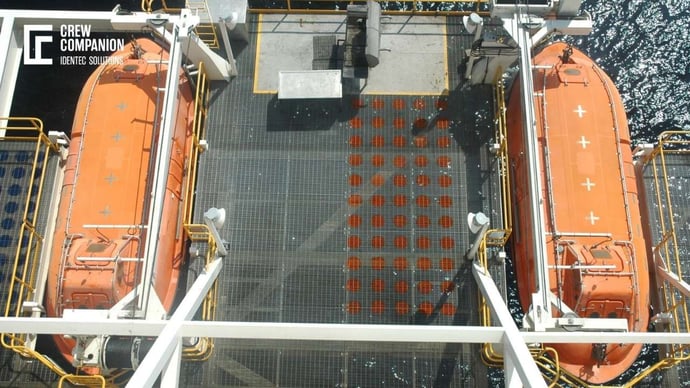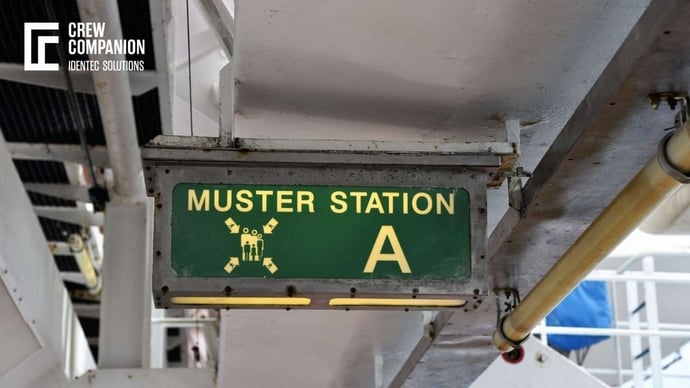Emergency Mustering on Offshore Installations
| Written by Mark Buzinkay
Keeping people safe and infrastructure protected is a number one priority for every organisation. Knowing where your staff are can make the difference between life and death in specific situations.
During an emergency, it is vital to know who has or has not left the hazardous area. The ability to track multiple people, at speed in a mass evacuation can prevent injuries, fatalities and loss.
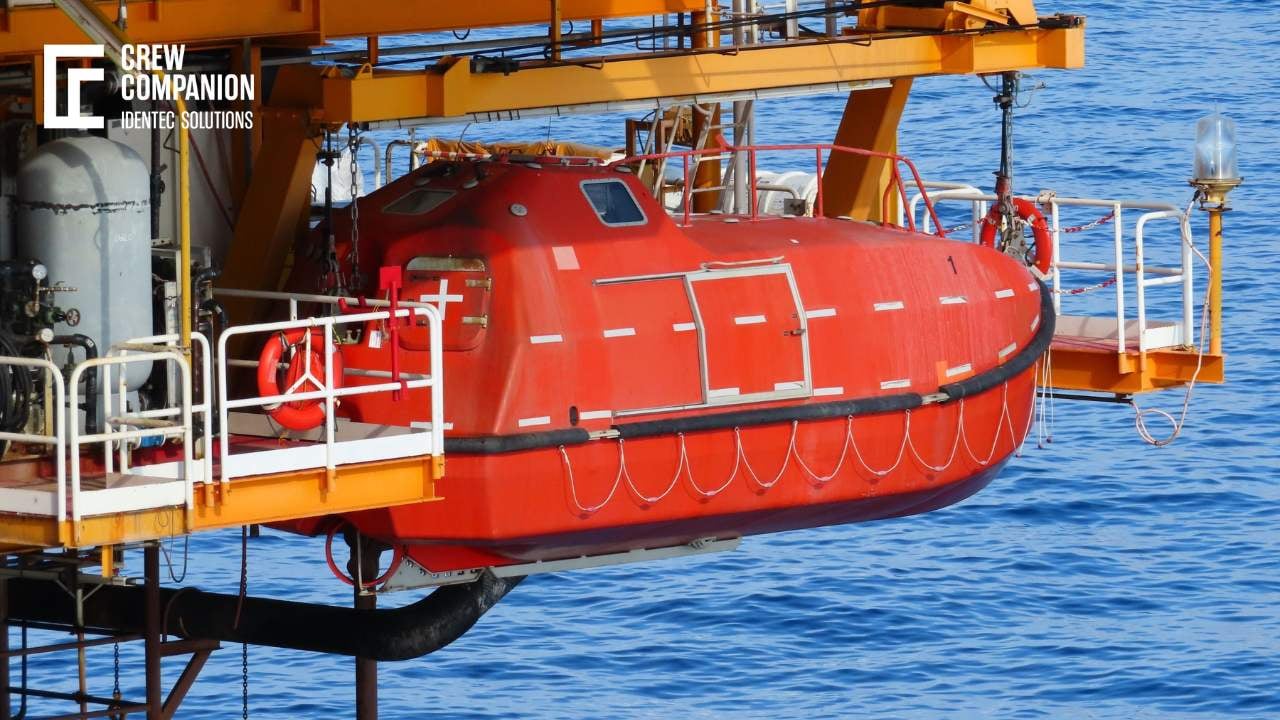
No video selected
Select a video type in the sidebar.
MANUAL EMERGENCY MUSTERING
Decades of evolution of safety legislation, industry codes of practice, feedback from incidents and the implementation of these across all industrial sectors have been essential in continuous improvement, and consequently, reducing the frequency of incidents and the need of evacuations from offshore platforms, vessels or other infrastructure at sea.
Manual mustering is (still) the most common approach employed to evacuate an offshore installation. Crew, contractors and visitors are guided to pre-identified muster points, which they are familiar with from the numerous drills undertaken during the normal course of work. The benefits of this approach are that it is very easy for staff to follow, the cost of employing such a system is low, and it is a process that is familiar to everyone in the workplace.
However, this approach has many inherent weaknesses. The system relies on a small number of trained personnel to undertake the subsequent roll call. These individuals are themselves evacuees and, as such, may not have the presence of mind to carry out their duties in a real-life evacuation; in the extreme case, they may not be available.
The manual mustering system also relies heavily on staff following procedures; however, when an actual evacuation takes place the primary focus of the individuals involved is often solely for their own safety. The system that performed adequately during drills may therefore significantly underperform.
The manual mustering system uses a number of identified mustering points close to the workstations facing evacuation. In a large-scale event, access to these areas may either be denied or extremely dangerous, rendering the carefully practiced procedures impossible to follow. In this event, employees' natural reaction is to rapidly disperse.
Paramount to the effectiveness of this system is knowledge of who was in the building at the point of evacuation. Very few organisations have the ability to explicitly identify who is on the premises at any given time. All but the most sophisticated access control systems are flawed, typically by staff’s lack of diligence in maintaining accurate records.
Learn more about Emergency Response Offshore...
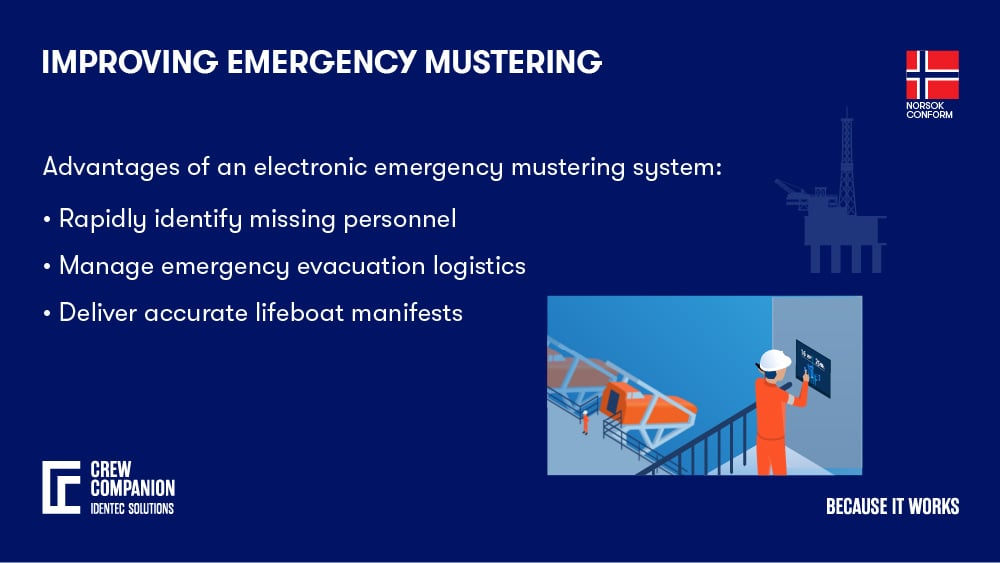
LESSONS LEARNED: MANUAL EMERGENCY MUSTERING IN REAL SCENARIOS
With rigorous training and regular practice, staff can be directed to muster for a traditional roll call. However, in a real life evacuation people’s natural instinct is to take flight from a threatening situation whether real or perceived. If a real evacuation becomes a requirement, many organisations find it extremely difficult to account for their staff.
One example from recent history shows that this still happens even with a trained crew. The fire and subsequent explosion of the Deepwater Horizon platform in the Gulf of Mexico in 2010 triggered an evacuation process. Due to the damage from the explosions, some mustering areas were not available anymore, and the assigned crew had to be redirected to alternate mustering areas. In the very threatening situation of extreme heat, flying debris, thunderous noise and fire, some crew members panicked and began abounding the installation prematurely, causing them to jump from a great heights into the sea (thanks to the benign weather conditions, they survived). If you are interested to learn more about oil rig safety during the Deepwater Horizon disaster, continue to read about oil rig safety and the Deepwater Horizon disaster.
The typical challenges of manual emergency mustering include:
MISSING PERSONNEL
Based on a muster list, every crew member is assigned to a muster area and a lifeboat. When the emergency alarm sounds, everyone on board will go to their dedicated muster points. This list is also used to check personnel at the muster point and is aligned with the T-Card board.
In a real emergency scenario, it can be challenging to check if everyone has arrived at their muster point. Chaos, hazardous conditions, and panic can make manual emergency mustering a nightmare. Hazardous conditions, people's behavioral changes, and panic can make the manual method of emergency mustering very challenging and stressful. The muster checkers manifest for the names of personnel can only confirm who has arrived at their muster point.
It is quite common on a global basis that personnel show up at the wrong muster point, this is always caused by panic by the individual or personnel not following the mustering / evacuation plans. The muster checker’s time is then taking up by having to follow their company process by alerting the control room and other muster checkers that this person is accounted for and not missing.
PERSONNEL NOT FOLLOWING EVACUATION PLAN
In a situation of life and death, the human follows two main reaction patterns: attack or flight. Even with training, some people will fall back to older patterns and leave the trained path. This can cause disruptions within the evacuation plan as people will be missing at mustering areas and appear at other muster points that they shouldn’t. There have been common scenarios with companies around the globe where personnel may become disoriented and lost in a changed environment (for instance, smoke limits visibility and destroyed gangways block escape routes), putting them in danger.
In a panic, personnel may also try to board lifeboats that they have not been dedicated to without checking in or just appearing at the incorrect lifeboat station. This slows down the evacuation process and makes reporting inaccurate. There is also a chance that the exit routes or assembly points are compromised.
BREAKDOWN IN COMMUNICATION
It has been quite common that handheld radios used for incident reporting can affect relayed communications due to background noise or radio interference. The desk phone reporting to the onshore Emergency Response Team/incident room will only be available until a full evacuation is declared, and then data communication is lost. ( I need to maybe rephrase or add more for this point.)
LIFEBOAT UNAVAILABILITY
Fire, explosions or other powerful impacts on offshore installations may damage or destroy available lifeboats. The release mechanism can become unfunctional, or the raft may have been torn off the rig. In this case, crew must change to their secondary dedicated lifeboat station. It is difficult for the responsible muster checker to command the crew without knowing their whereabouts. In a serious incident, moving them from point A to point B through hazardous areas without losing personnel on the way can be very challenging. The responsible person has to be 100% sure who arrived at the alternate lifeboat in real time. If someone went missing, a search-and-rescue team must be deployed.
As described, effective management of emergency evacuation is challenging. Ensuring that evacuation routines are regularly practiced, accurately recorded, and critically reviewed for continuous improvement are the basics of proper offshore emergency response. They save time when time becomes most valuable: In an emergency situation.
In today’s offshore installations, the following systems and procedures for POB count are common practice and can be classified as follows:
- Class 1 mustering systems: User interaction required, manual POB records taken, e.g., tossing tokens into a basket when crossing a bridge between two assets.
- Class 2 mustering systems: User interaction required, POB recorded electronically, e.g., swiping personalized badges when entering or exiting an asset.
- Class 3 mustering systems: No user interaction required, POB recorded electronically, e.g., users wearing personalized transponders that provide zone accurate POB.
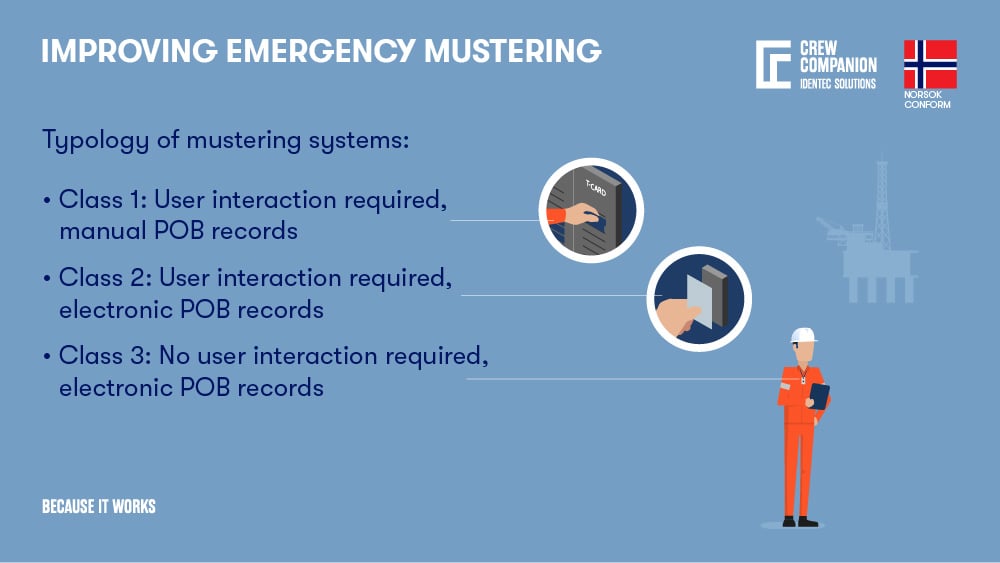
ELECTRONIC EMERGENCY MUSTERING: INCREASING OFFSHORE SAFETY
If the main risks raised by manual mustering are the use of physical muster points that may not be available, small numbers of trained and disciplined staff to conduct roll calls and the other mentioned above, then surely class 1 systems introduce risk into a process through inherent weaknesses in their design.
An electronic emergency mustering system (check: RFID mustering) is based on the principles of visibility and accessibility. The main idea is to let the system do the registration at the mustering point and the communication with the operational headquarters, avoiding the pitfalls of manual mustering. Such an emergency evacuation system is based on personnel active tags communicating automatically with readers, transferring data to a central server.
The typical advantages of an electronic emergency mustering system include:
RAPIDLY IDENTIFY MISSING PERSONNEL
Using an automated roll-call, emergency mustering is much smoother. It delivers accurate headcounts in real-time and missing personnel can be rapidly identified, you instantly know who is missing. Emergency managers or muster checkers can check the system’s automated roll on their tablets or PC’s to confirm who has been registered and who is still unregistered. Additionally, such a system can display the last known location of missing personnel as the starting point for any search-and-rescue mission only if that area has reader coverage. On big offshore and onshore installations, mobile mustering solutions may play a valuable role.
MANAGE EMERGENCY EVACUATION LOGISTICS
Because an electronic emergency mustering solution knows where the crew are at any time, it is much easier to deploy the right teams and assets at the right places. At any time, the emergency teams is in full control who sits in which lifeboat, where personnel with special skills is located and can be used for ad-hoc missions to fight fires, search for missing crew or other tasks.
LIFEBOAT MANIFESTS
One of the very important aspects of offshore evacuations is accurate information about evacuated crew. Control room, onshore organisations and relatives want to know who has been evacuated. When mustering is done manually, lifeboat manifests may not be accurate, complicating things and potentially put search-and-rescue teams in avoidable danger.
These advantages by class 3, and to some extent class 2 mustering systems, ask for specific performance attributes. Electronic emergency mustering systems must be resilient and scalable to deal with many potential situations. It must also be simple to use and employ ubiquitous, non-location dependent technology. The key to an emergency mustering system is its ability to provide simple, rapid, and accurate information for reporting to any number of relevant parties.
Such a system can then be used to manage any unexpected changes to the muster point, allowing evacuees to disperse to any suitable safe location. This could be based either on direction received from the emergency services or a self-assessment of the situation at hand. Upon arrival at the muster point, the electronic emergency mustering system can simply and quickly confirm the new evacuation status.
A virtual mustering system (read more about emergency response software) also comes into its own should there be staff who are unaccounted for by conventional means. In this case the crisis communications system can be used to proactively attempt to make immediate contact with these people and ensure that they that they verify their evacuation status.
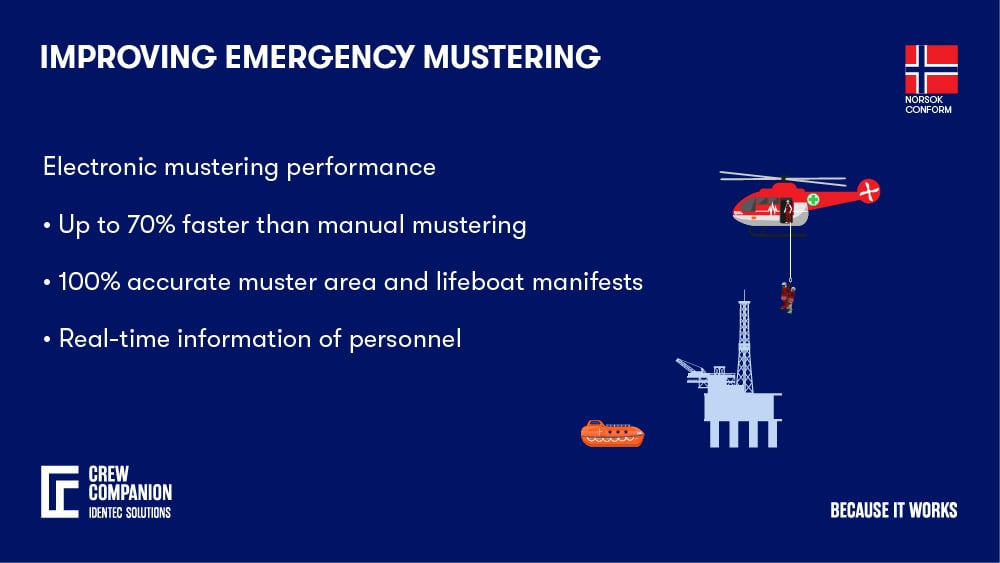
Emergency Mustering - TAKEAWAY
It is well accepted that human factors play a major role in platform musters and their outcome. While looking at the classes 1 to 3 from above, it is unquestionable that class 3 systems excel in excluding the human factor during mustering. Both class 2 and class 3 systems would fall under the category “electronic mustering”, yet only class 3 systems define the gold standard for accurate POB count on offshore assets.
 Read all about Emergency Response Management!
Read all about Emergency Response Management!
Sources:
(1) Panaretou, Ioannis, Hadjithephanous, Stavros, Kassapoglou-Faist, Corinne, Dallemange, Philippe, Louloudi, Sofia, Karadimas, Dimitrios, Panagiotou, Christos, Kostopoulos, Charalampos, Michail, Konstantinos, and Anastasis Kounoudes. "OffshoreMuster: An Integrated Real Time Localisation, Mustering and Evacuation Management System for Offshore Oil & Gas Health and Safety Operations." Paper presented at the Abu Dhabi International Petroleum Exhibition & Conference, Abu Dhabi, UAE, November 2021. doi: https://doi.org/10.2118/207661-MS
Note: This article was updated on the 4th of November 2024

Author
Mark Buzinkay, Head of Marketing
Mark Buzinkay holds a PhD in Virtual Anthropology, a Master in Business Administration (Telecommunications Mgmt), a Master of Science in Information Management and a Master of Arts in History, Sociology and Philosophy. Mark spent most of his professional career developing and creating business ideas - from a marketing, organisational and process point of view. He is fascinated by the digital transformation of industries, especially manufacturing and logistics. Mark writes mainly about Industry 4.0, maritime logistics, process and change management, innovations onshore and offshore, and the digital transformation in general.
Related Articles
Related Product

